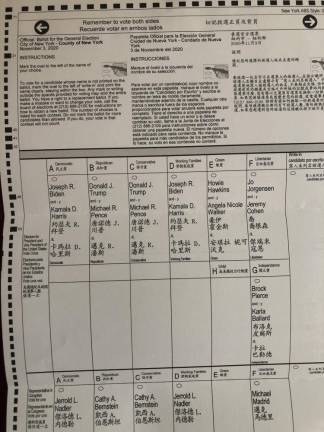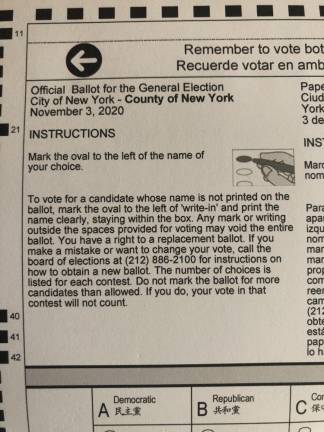The Case of the Botched Ballot
Or how one Manhattan resident discovered an error just like one made 10 years ago


Mistakes happen. But at the New York City Board of Elections they seem to happen again and again. In fact, the absentee ballot I received in Manhattan recently contains a mistake that seems remarkably like the mistake the Board of Elections made ten years ago on the election day ballot.
The instructions on my mail ballot were spare and simple, in both English and Spanish (I don’t read Chinese): “Mark the oval to the left of the name of your choice.” In case you aren’t used to standardized tests, there is a helpful image of a hand filling in an oval with a pen.
The problem cropped up as I examined my ballot. There were NO OVALS to the left of the names of Biden or Trump or, for that matter, Howie Hawkins (Green Party) or Jo Jorgensen (Libertarian). The only oval to the left of anything was the space to write in a candidate, which had not been part of my civic plan.
All the other ovals were ABOVE the names of the candidates.
Ballot design is challenging. There are a thousand ways to confuse a voter or the machine or election official who later reads the ballot to judge the voter’s intention.
This particular blunder left me, the dutiful citizen, with what seemed like three choices. I could guess that what the Board of Elections actually MEANT when it wrote “to the left” was “above.” Or I could mark the ballot to the left as instructed even though there was no oval. Or I could scrap the mail vote entirely and go vote in person, defeating the goal of retarding the spread of coronavirus by reducing crowding at the polls.
New Yorkers have grown inured to election ineptness. After all, we the people put the political parties in charge of running elections in New York and, surprise, there always seems to be a whiff of politics. It was a Republican-connected printing house upstate that sent 99,000 mail ballots to Brooklyn voters last week with misaddressed return envelopes with the names of other voters on them.
Call for Help
No one at the Board of Elections responded to my emails and phone calls. So for help with this ballot thicket I called one of New York’s top experts on voting, Lawrence Norden, Director of the Election Reform Program at the Brennan Center for Justice in lower Manhattan.
Norden is the kind of guy who gives the keynote address at the Votobit International Conference on Electronic Voting in Buenos Aires or the Electronic Voting Technology and Trustworthy Elections workshops in Montreal. He helped the state of Ohio improve their voting systems.
This is his busy season, what with President Trump denouncing the legitimacy of voting in every way he can. But Norden quickly got on the phone.
“It’s kind of amazing,” he said of the Board of Elections and the misplaced oval (or bad instructions, as you prefer). “As it happens I discovered a similar problem with the ballots in 2010.”
Similar is diplomatic. It seemed the same mistake twice to me. Or in fairness, the inverse mistake.
On that ballot in 2010 the instruction was: “To vote for a candidate whose name is printed on this ballot, fill in the oval above or next to the name of the candidate.”
You have probably already guessed this. In 2010, the correct oval was below the name. Now 2010 was the year the city junked those old mechanical voting machines, the ones with the big levers, and moved to electronic scanners, which read these ovals.
So perhaps the Board of Elections got a bit of a pass when it explained that the error was because of a conflict between instructions in state law and the challenge of fitting everything on a ballot the new machines could read.
But repeating the mistake this year exemplifies what Norden and many others describe as consistent weakness at The Board of Elections. “The city board doesn’t have a voter-friendly attitude,” Norden said.
Separate Election Bodies
If voting supervision by the parties in New York City was competent we might have a different discussion. After all, integrity, as George Washington Plunkett of Tammany Hall reminded us, is no substitute for experience. As it is, the current system here is, well, behind the curve.
“The nature of election administration today highlights the need for professionalization of the field,” The National Conference of State Legislatures wrote earlier this year. Norden points out that other big jurisdictions conduct national searches to find an experienced manager of elections. The top LA county voting officer, Norden noted, was lured away from King County, which includes Seattle. “I have not seen that at the city board.”
Running elections in the United States is the job of 10,000 separate state, county and local election bodies. There is an upside to this. “The dispersed responsibility for running elections,” The NCSL wrote, “makes it extremely difficult, if not impossible, to rig U.S. elections at the national level.”
The decentralization also “allows individual jurisdictions to experiment and innovate – to see how elections might best be run,” the NCSL added. New York City has clearly allowed other jurisdictions to take the lead on that role.
As much of a critic as Norden is, he points out that running an election in a city of eight million is a big challenge and sometimes the Board of Elections is too easy a target.
“At the same time, there is no question a big problem with the City Board is that they [Board members] seem accountable to no one,” Norden added. “It’s the parties that nominate them, and the City Council that votes on them. This is one area where the City Council would seem to be able to exert some more control if it wanted, but as far as I know, it never has.”
“A big problem with the City Board is that they [Board members] seem accountable to no one ... This is one area where the City Council would seem to be able to exert some more control if it wanted, but as far as I know, it never has.” Lawrence Norden, Brennan Center for Justice